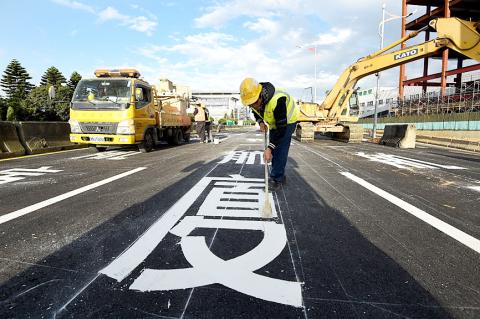The Ministry of Transportation and Communications yesterday said it is aiming to begin construction of terminal 3 at Taiwan Taoyuan International Airport in September next year and it would not remove the design for a cloud-shaped ceiling from the plan.
Deputy Minister of Transportation and Communications Chi Wen-chung (祁文中), who is also acting chairman of Taoyuan International Airport Corp (TIAC), made the statement at a meeting of the legislature’s Transportation Committee, which was reviewing the budget submitted by the airport company for the next fiscal year.
The ministry previously said it postponed completion of terminal 3 to the end of 2023 after the company twice failed to attract bidders through public-tender sessions.

Photo: Chu Pei-hsiung, Taipei Times
The postponement has added NT$3.6 billion (US$116.7 million) to the construction budget, increasing it to NT$78.2 billion, the company said.
Lawmakers in the Transportation Committee said that they were dissatisfied with repeated delays in launching construction.
Democratic Progressive Party (DPP) Legislator Chen Ming-wen (陳明文) said that the company has delayed the start of construction three times, increasing the annual budget for professional services to hire a consulting firm to help the airport company manage construction plans.
TIAC has fared poorly in its performance and its budget should be cut by NT$20 million, Chen said.
DPP legislators Cheng Pao-ching (鄭寶清) and Lee Kun-tse (李昆澤) also said that its budget should be cut.
TIAC from 2012 to 2015 received funds to pay a technical service fee to a consulting firm that helped it manage construction plans for the terminal and a third runway, and now it is seeking additional funds for a professional management fee, Cheng said.
This is an example of frivolous spending, Cheng said.
The terminal project has been divided into a contract for civil engineering work and one for building the electrical and mechanical core network, Chi said, adding that TIAC is aiming to conclude public-tender sessions for the two contracts in March.
“We are aiming to start construction in September. If the tenders in March fail, a second tender in June must succeed,” he said.
“The company does not have enough workers to complete all of the work, with the workload expected to increase in the years to come,” he said. “As hiring full-time staff would create a problem when it came time to cut personnel, it is only reasonable to outsource management of construction to a consulting firm.”
The company would work hard to achieve the best performance, Chi said.
TIAC had planned to remove a cloud-shaped ceiling — the main feature of the terminal — from the plans to shorten construction time and reduce maintenance costs, but said it would keep the design.
Maintenance of the ceiling, which is to be built with 130,000 aluminum pipes, is estimated to cost NT$1.7 billion annually.
“The ceiling would be a main feature of terminal 3 and an expression of the nation’s architectural skills. It would be a pity to abandon the design,” TIAC vice president Chen Fu-chiang (陳福將) said.
The pipes are to be made of stainless steel rather than aluminum and a special maintenance vehicle would be built to facilitate maintenance, Chen Fu-chiang said.

Taiwan is to commence mass production of the Tien Kung (天弓, “Sky Bow”) III, IV and V missiles by the second quarter of this year if the legislature approves the government’s NT$1.25 trillion (US$39.78 billion) special defense budget, an official said yesterday. Commenting on condition of anonymity, a defense official with knowledge of the matter said that the advanced systems are expected to provide crucial capabilities against ballistic and cruise missiles for the proposed “T-Dome,” an advanced, multi-layered air defense network. The Tien Kung III is an air defense missile with a maximum interception altitude of 35km. The Tien Kung IV and V

The disruption of 941 flights in and out of Taiwan due to China’s large-scale military exercises was no accident, but rather the result of a “quasi-blockade” used to simulate creating the air and sea routes needed for an amphibious landing, a military expert said. The disruptions occurred on Tuesday and lasted about 10 hours as China conducted live-fire drills in the Taiwan Strait. The Civil Aviation Administration (CAA) said the exercises affected 857 international flights and 84 domestic flights, affecting more than 100,000 travelers. Su Tzu-yun (蘇紫雲), a research fellow at the government-sponsored Institute for National Defense and Security Research, said the air

A strong continental cold air mass is to bring pollutants to Taiwan from tomorrow, the Ministry of Environment said today, as it issued an “orange” air quality alert for most of the country. All of Taiwan except for Hualien and Taitung counties is to be under an “orange” air quality alert tomorrow, indicating air quality that is unhealthy for sensitive groups. In China, areas from Shandong to Shanghai have been enveloped in haze since Saturday, the ministry said in a news release. Yesterday, hourly concentrations of PM2.5 in these areas ranged from 65 to 160 micrograms per cubic meter (mg/m³), and pollutants were

Taiwan lacks effective and cost-efficient armaments to intercept rockets, making the planned “T-Dome” interception system necessary, two experts said on Tuesday. The concerns were raised after China’s military fired two waves of rockets during live-fire drills around Taiwan on Tuesday, part of two-day exercises code-named “Justice Mission 2025.” The first wave involved 17 rockets launched at 9am from Pingtan in China’s Fujian Province, according to Lieutenant General Hsieh Jih-sheng (謝日升) of the Office of the Deputy Chief of the General Staff for Intelligence at the Ministry of National Defense. Those rockets landed 70 nautical miles (129.6km) northeast of Keelung without flying over Taiwan,